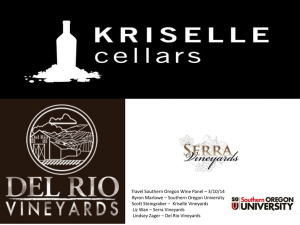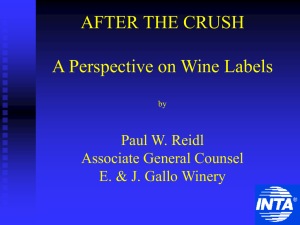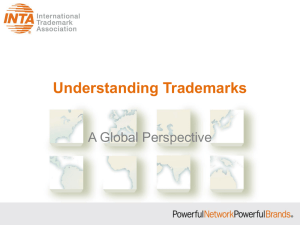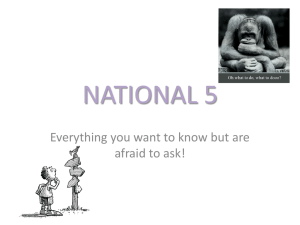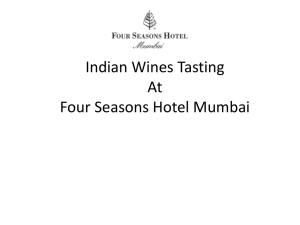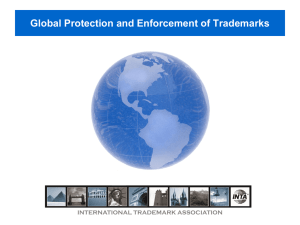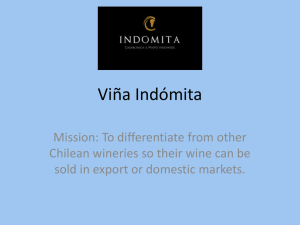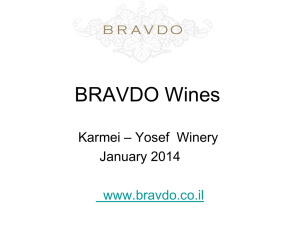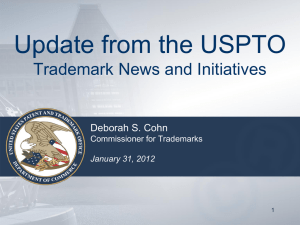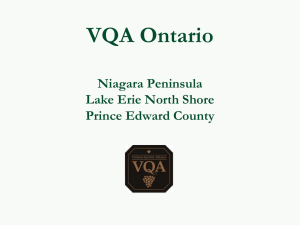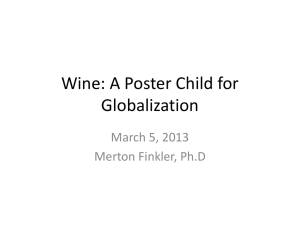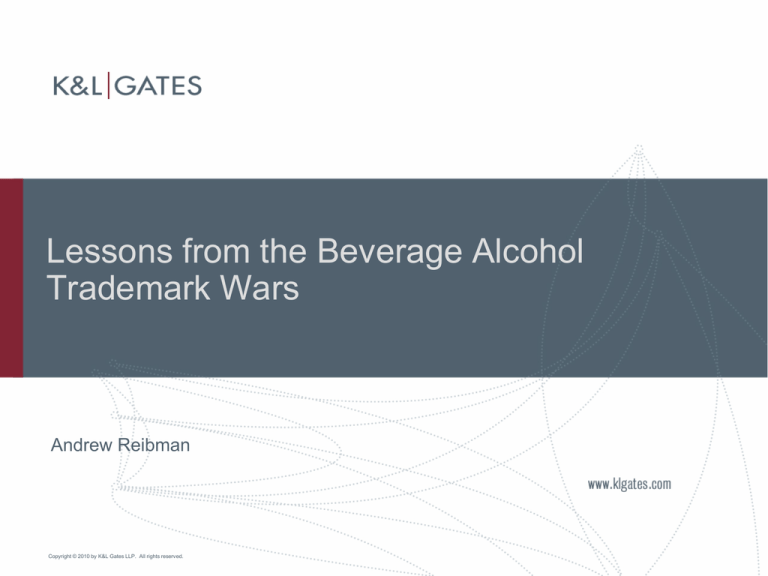
Lessons from the Beverage Alcohol
Trademark Wars
Andrew Reibman
Copyright © 2010 by K&L Gates LLP. All rights reserved.
Copyright © 2010 by K&L Gates LLP. All rights reserved.
5 Minute Trademark Law Primer
2
Trademarks are Indicia of Source
Word: Budweiser
Stylized Words:
Phrase: It’s Miller Time
Words with Design:
Design or Logo:
3
Key Elements of a Protectable Trademark
Indicia of source
Distinctiveness
Priority
Technical trademark use
… bona fide use as a trademark
… in the ordinary course of trade
... on goods or their containers (with exceptions)
… in interstate commerce in the United States
4
In the United States, Rights Arise from Use
Prior use generally defeats later registration
Greater scope of use leads to greater rights
Common law rights may arise from use even without
registration
“Intent to use” application, allows placeholder in time
to be perfected when use begins
5
Likelihood of Confusion -- The Dupont Factors
Similarity of the marks
Relatedness of the goods or services
Similarity of trade channels
Conditions of purchase and sophistication of buyers
Number and nature of similar marks in use on
similar goods (strength of mark)
6
Some Benefits of Federal Registration
Prima facie evidence of ownership and use
Possibility of attorneys’ fees and greater damages in
infringement actions
Blocks registration of confusingly similar marks
Allows customs service blocking of importation of infringing
goods
Incontestability after five years on principal register
Notice/warning to others
7
Recent Trademark Law Developments
Told (mostly) Through
Recent Beverage Alcohol Trademark Cases
8
Likelihood of Confusion Issues
9
Likelihood of Confusion
Applied for:
Existing Registration:
In re S.A. Establecimientos Vitivinicolas Escorihuela,
2008 WL 4354166 (Trademark Tr. & App. Bd.)
10
Held: Confusingly Similar
Same goods: Both for wine
Similarity of mark: Average purchaser will recollect
“Don Miguel”
“Don Miguel” more prominent than design features
Practice note: Burdens of proof are less for an
opposer than for someone enforcing against an
infringer
11
Likelihood of Confusion
In re Taylor Wines Pty Ltd., 2008 WL 5078735 (Trademark Tr. &
App. Bd.)
12
Held: Confusingly Similar
Goods:
“Wine” encompasses “Red & White Still Wines”
Similarities of the mark:
Consider marks in their entirety.
Less weight to generic or descriptive portion.
More weight to word, when combined with design.
“St. Andrew’s” is the dominant portion of both marks.
Strength of marks: Discount existing St. Andrew’s marks,
because they are for whiskey
13
Likelihood of Confusion: Foreign Equivalents
LUZ DE ESTRELLA
STARLITE VINEYARDS
In re Armstrong Vineyards and Winery,2008 WL 78849329
(Trademark Tr. & App. Bd.)
14
Result: Confusing
When it is likely that the ordinary American
purchaser would stop and translate the term, must
consider translation
Significant portion of the consuming public is
knowledgeable in Spanish
15
Likelihood of Confusion:
Foreign But Different?
QUINTA DO PORTAL
for “wine”
QUINTA DO PORTA
for “port wine”
In re Sociedade Quinta do portal, SA, 2008 WL 2619526
(Trademark Tr. & App. Bd.)
Result: Confusing - virtually indistinguishable to average,
English speaking consumers
16
Likelihood of Confusion: Alcoholic Beverages
Related?
Bell’s Brewery
BELL HILL for “packaged wine”
for “beer, including porter,
ale, stout, and malt liquor”
Bell’s Brewery v. Bell Hill Vineyards, LLC, 2009 WL 5118319
(Trademark Tr. & App Bd.)
17
Result: Not Confusing
Channels of commerce and consumers related
However, Opposer failed to establish that it is a
common practice for beer and wine to be distributed
under the same mark.
Practice Tip: Result probably depended on factual
presentation – establishing the story and factual
predicates is important.
18
Likelihood of Confusion: Relationship of
Alcoholic Beverages
for “energy vodka infused with
caffeine”
for “sparkling fruit wine; sparkling
grape wine; sparkling wine; wines”
In re White Rock Distilleries, 2009 WL 4081675 (Trademark Tr. & App. Bd.)
19
Result: Not Confusing
Wine and vodka could be sold from the same source,
and wine grapes can be used to make vodka
However, there is no per se rule that all alcoholic
beverages are related, and it was not established that
applicant’s vodka, and registrant’s wine would be
considered to emanate from the same mark, or are
otherwise related
Likelihood of Confusion: Relationship of
Alcoholic Beverages
In re Nagy, 2009 WL 4086572
(Trademark Tr. & App. Bd.)
for “sake”
for “distilled spirits, namely
vodka”
for: “wine”
21
Result: Confusing
Although there is no per se rule that all alcoholic
beverages are related, here the examining attorney
noted eleven use-based third party registrations in
which vodka, wine and sake are all included in the
identifications of goods, as well as evidence of
products such as wine flavored vodka, vodka distilled
from wine, and vodka blended with sake
Likelihood of Confusion: Relationship of
Alcoholic Beverages with Restaurant Services
for “wine”
for “restaurant services”
In re Wente Bros dba Tamas Estates, 2009 WL 4085608 (Trademark Tr. & App. Bd.)
23
Result: No Likelihood of Confusion
“Something more” than just a restaurant and wine with
similar name is required
Winery has a restaurant at vineyard
Restaurant has a picture of a bottle of wine in ad
Not enough!
Dicta: Related type of food or beverage (e.g., Mexican)
might be enough. Alternative might be restaurant sells
specific wine type.
24
Relationship with Other Types of Goods
Existing Mark:
BUDWEISER
New Mark:
BUTTWIPER
Anheuser-Busch v. VIP Products, 2008 WL 4619702 (E.D. Mo)
25
Result: Preliminary Injunction Granted
(subsequently settled)
Survey showed actual confusion amongst 1 in 3
people
Benefit given to famous mark
26
Likelihood of Confusions – High and Low End
Goods
WILLIAM COLE
WILLIAM COLE VINEYARDS
Existing Mark:
For “wine”, but it’s $8 wine….
Applicant’s Mark:
For “wine”, but it’s $125-180 wine
In re William Cole Vineyards, LLC, 2008 WL 5078726
(Trademark Tr. & App. Bd.)
27
Result: Confusion Still Likely
Applicant argued channels of trade are different,
because shelf would never be the same, or even in
the same retail location
However, in oppositions, registrations are not limited
based on current use
Think about: what if the registration was for “cheap
jug wine”
28
Functionality and Product Design
29
Functionality – Some Background
If packaging is functional, the design or packaging cannot serve as a
trademark. Qualitex Co. v. Jacobson Prods. Co., 514 U.S. 159, 164
(1995); 15 U.S.C. § 1052(e)(5)
When “packaging of a product” comprising trade dress also satisfies
the federal standards of trademark protection, registration is allowed
on the principal register
Supreme Court has characterized trade dress as the “design or
packaging of a product” which has acquired a “secondary meaning”
sufficient “to identify the product with its manufacturer or
source.” TrafFix Devices, Inc. v. Mktg Displays, Inc., 532 U.S. 23, 28
(2001)
30
Makers Mark v. Diageo North America 2008
WL 4165456 (W.D. KY.)
D’s motion for summary judgment that Maker’s Mark wax seal is
functional and generic denied; case continues…
31
Geographic Marks
Geographic Indication Must be Proper
15 U.S.C. §§ 1052
No trademark by which the goods of the applicant
may be distinguished from the goods of others shall
be refused registration on the principal register on
account of its nature unless it–
(a) Consists of or comprises ... deceptive ... matter;…
or a geographical indication which, when used on or in
connection with wines or spirits, identifies a place
other than the origin of the goods and is first used on
or in connection with wines or spirits by the applicant
on or after [January 1, 1996].
...
Geographic Descriptiveness
15 U.S.C. §§ 1052.
No trademark by which the goods of the applicant
may be distinguished from the goods of others shall
be refused registration on the principal register on
account of its nature unless it–
…
(e) Consists of a mark which ... (2) when used on or in
connection with the goods of the applicant is
primarily geographically descriptive of them,
except as indications of regional origin may be
registrable under section 4, (3) when used on or in
connection with the goods of the applicant is primarily
geographically deceptively misdescriptive of
them....
Is it geographically misdescriptive?
Mark: Moskovskaya
But not from Moscow
In re Spirits International, 563 F.3d 1347 (2009)
Holding: remanded
TTAB improperly applied materiality test of Section
2(e)(3)
Board failed to consider whether a substantial portion
of all relevant consumers (not just Russian speakers)
is likely to be deceived.
Famous Foreign Marks
37
Famous Foreign Marks in the U.S.
Do famous foreign marks acquire any rights in the
U.S. without use or registration?
38
Famous Foreign Marks
Grupo Gigante v. Dallo, 391 F.3d 1088 (9th Cir. 2004)
Famous Mexican grocery chain, but no U.S. use
Plaintiff may be allowed to pursue infringement claim
based on its famous mark in Mexico
Required “a substantial portion of the consuming
public” is familiar with the foreign mark.
39
Famous Foreign Marks – Bukhara Grill
ITC Ltd v Punchgini, Inc., 482 F3d 135 (2nd Cir. 2007)
40
Result:
No federally protected rights for foreign famous
marks
Certified to NYCA for state law claims – which were
found to exist, but are quite limited.
Result: Well-Known (Famous) Marks in the EU
Budejovicky Budvar Narodni Podnik v. Anheuser
Busch Inc., 2009 EWCA Civ 1022
43
Fraud:
Shifting, Lower Standards
44
In re Bose Corporation, 91 USPQ2d 1938 (Fed.
Cir. 2009)
Bose’s registration covered audio tape recorders, in
addition to other goods.
Bose acknowledged that it stopped manufacturing
and selling audio tape recorders and players in 199697.
Subsequently filed renewal with statement of use
including these goods.
TTAB held statement was false and not reasonable.
45
Bose Holding on Appeal:
TTAB’s Medinol’s Should Have Known standard
overturned
The Board, "[b]y equating 'should have known' with
a subjective intent," had "erroneously lowered the
fraud standard to a simple negligence standard."
"[u]nless the challenger can point to evidence to
support an inference of deceptive intent, it has failed
to satisfy the clear and convincing evidence standard
required to establish a fraud claim."
46
Fraud on the Trademark Office
Willful Intent To Deceive
Reckless Disregard (or
Willful Blindness?)
Gross Negligence (not
enough under Bose)
Negligence/Should Have
Known (old Medinol
Standard – overturned in
Bose)
Inadvertence
47
Practice Tips
Some Practice Tips
Search and clear before launch.
Seek benefits of Federal Registration even for
ancillary marks and design features.
Contested cases are fact intensive – create a good
story and be careful with those emails!
Questions & Follow-up
Andrew Reibman
andrew.reibman@klgates.com
(212) 536-4074 (direct)

